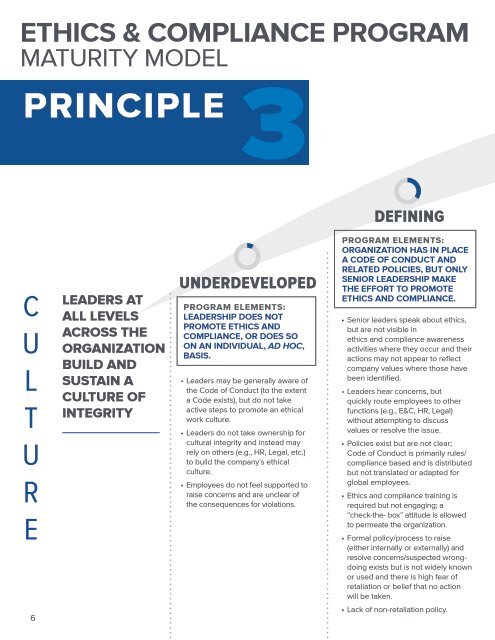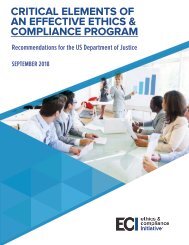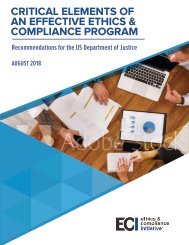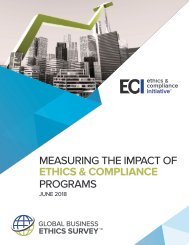ECI Maturity Model - DRAFT
Create successful ePaper yourself
Turn your PDF publications into a flip-book with our unique Google optimized e-Paper software.
ETHICS & COMPLIANCE PROGRAM<br />
MATURITY MODEL<br />
PRINCIPLE<br />
3<br />
DEFINING<br />
C<br />
U<br />
L<br />
T<br />
U<br />
R<br />
E<br />
LEADERS AT<br />
ALL LEVELS<br />
ACROSS THE<br />
ORGANIZATION<br />
BUILD AND<br />
SUSTAIN A<br />
CULTURE OF<br />
INTEGRITY<br />
UNDERDEVELOPED<br />
PROGRAM ELEMENTS:<br />
LEADERSHIP DOES NOT<br />
PROMOTE ETHICS AND<br />
COMPLIANCE, OR DOES SO<br />
ON AN INDIVIDUAL, AD HOC,<br />
BASIS.<br />
• Leaders may be generally aware of<br />
the Code of Conduct (to the extent<br />
a Code exists), but do not take<br />
active steps to promote an ethical<br />
work culture.<br />
• Leaders do not take ownership for<br />
cultural integrity and instead may<br />
rely on others (e.g., HR, Legal, etc.)<br />
to build the company’s ethical<br />
culture.<br />
• Employees do not feel supported to<br />
raise concerns and are unclear of<br />
the consequences for violations.<br />
PROGRAM ELEMENTS:<br />
ORGANIZATION HAS IN PLACE<br />
A CODE OF CONDUCT AND<br />
RELATED POLICIES, BUT ONLY<br />
SENIOR LEADERSHIP MAKE<br />
THE EFFORT TO PROMOTE<br />
ETHICS AND COMPLIANCE.<br />
• Senior leaders speak about ethics,<br />
but are not visible in<br />
ethics and compliance awareness<br />
activities where they occur and their<br />
actions may not appear to reflect<br />
company values where those have<br />
been identified.<br />
• Leaders hear concerns, but<br />
quickly route employees to other<br />
functions (e.g., E&C, HR, Legal)<br />
without attempting to discuss<br />
values or resolve the issue.<br />
• Policies exist but are not clear;<br />
Code of Conduct is primarily rules/<br />
compliance based and is distributed<br />
but not translated or adapted for<br />
global employees.<br />
• Ethics and compliance training is<br />
required but not engaging; a<br />
“check-the- box” attitude is allowed<br />
to permeate the organization.<br />
• Formal policy/process to raise<br />
(either internally or externally) and<br />
resolve concerns/suspected wrongdoing<br />
exists but is not widely known<br />
or used and there is high fear of<br />
retaliation or belief that no action<br />
will be taken.<br />
6<br />
• Lack of non-retaliation policy.








